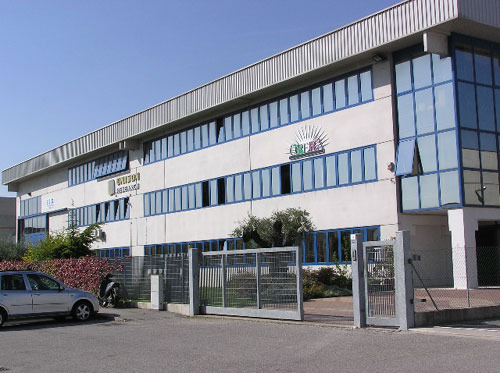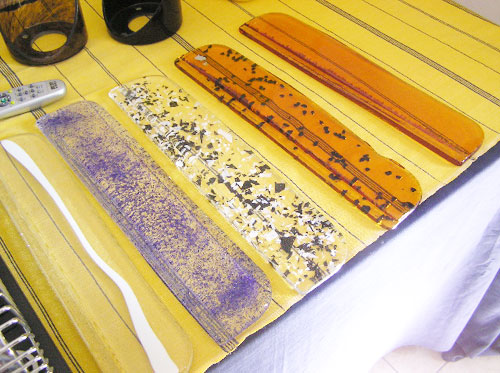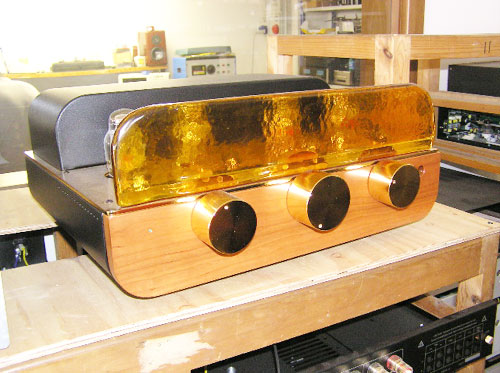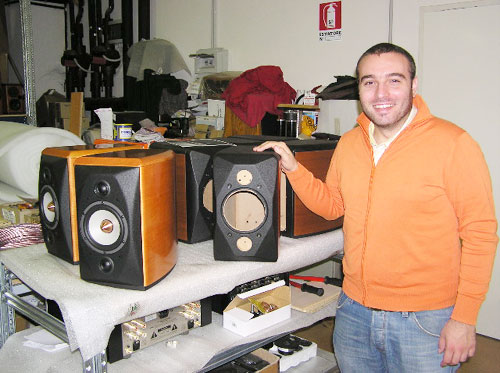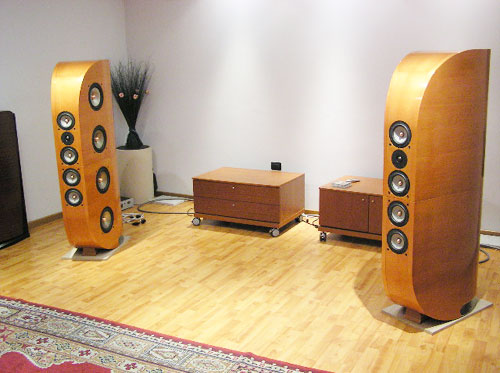![[SoundStage!]](../sslogo3.gif) The Traveler The TravelerBack Issue Article |
April 2008 Giro del Veneto: Unison Research and Opera Loudspeakers After two days in Vicenza, I took a train to Venice, that magical island city on the Adriatic Sea. I arrived during a huge thundershower and took a water taxi to my hotel at the far end of the Grand Canal, where I arrived under dramatic, clearing skies and a sunset that backlit the purple clouds in burnished gold like a ceiling fresco by Tiepolo. The next day marked a seasonal shift from late summer to early fall, as, when I woke and stepped outside, the air was crisp, clear, and washed completely clean. Around 9:00, I took a leisurely stroll along the Grand Canal and over a few foot bridges toward the Piazza San Marco and caught the vaporetto back up the great waterway to the Piazzale Roma, the vehicular gateway to Venice, where Bartolomeo Nasta, export manager of Unison Research, met me at the curb of a circle drive. We got into his car and sped across the causeway to the mainland, then took a tree-lined highway north through suburbs and gorgeous Italian countryside to a small town near Treviso and the Unison Research/Opera Loudspeakers factory. As with others whose factories I'd visited on this trip, I'd met Bartolomeo at the Top Audio show. He said Unison had been located in Vicenza until 2003, but, in order to consolidate locations with Opera, both companies moved to Dosson di Casier four years ago. In about twenty minutes, we pulled up to a boxy three-story glass-and-concrete building with the twin logos of Unison Research and Opera Loudspeakers across its facade.
Once we entered the main factory floor upstairs, we moved quickly through areas of metal shelves stacked with output transformers in plastic wrap and slotted wooden carts filled with newly assembled Unison integrated amps to a more open shop area where aproned workers stooped over benches and tables. The building is about 2000 square meters and houses 20 full-time office and factory workers. Unison/Opera has already bought an adjacent building, which will add another 2000 square meters of space to their joint operation. In total, Unison and Opera together ship about 300-400 units per month. Looking around, I saw three workers sitting at soldering stations, elephantine chutes of yellowing plastic sucking away the wisps of metallic fumes as they worked. There was soft, slight motion everywhere, smooth in rhythm and relaxed in pace -- the opposite of a bustling fabricator's or a train station, more like a flock of weekenders intent at a game of bocce on the beach. Amidst all the workers at their benches and carts full of equipment around the floor, I recognized a familiar face -- Giovanni Sacchetti's. He extended his hand in greeting and I took it, eager to speak with him again about Unison and the equipment he designed. Sacchetti founded Unison Research in 1987, formed the partnership with Giovanni Nasta (Bartolomeo's father) of Opera Loudspeakers in 1999, and is still chief engineer of Unison's gorgeous valve amplifiers, while consulting on design for most all their equipment. We'd met at Top Audio just a few days before, where he was introducing his new P70 push-pull integrated amplifier ($7995). Bartolomeo excused himself, and I followed Mr. Sacchetti. He said he wanted to show me something he couldn't at Top Audio, and ushered me to a corner table, where I saw four luscious, translucent slabs of Murano glass in varying colors.
"You see?" Sacchetti said proudly. "Here are the options for the glass faceplate of the P70." These were exactly like the jewelry Murano is famous for -- lusciously fine, crenellated surfaces in striking colors and exquisite patterns.
"It is for the living room, no?" Sacchetti joked. "When one is tired of a certain color or wants to dress up the look for a party -- Eccola! -- one just changes the glass and the look is transformed." Sacchetti grinned like a Leprechaun when he said this, and I found it completely charming to see this accomplished audio engineer so pleased with what was essentially a feature of décor that had nothing to do with electronics or sound. But it made sense in many ways, as each of his tube amplifiers has a distinctive look that has appeal to the eye as well as to the ear. The new P70 is no different and may well extend the Unison line's reputation as glamorous and sensual objets d' art.
We strolled among tables crowded with integrated amplifiers and CD players in various states of assembly, Sacchetti pointing things out and narrating along the way. There were a partially competed Unison S8 ($8325) being electronically tested and printed circuit boards for the Unico 100 ($5525). Although Unison Research toroidal transformers for push-pull Unico integrateds and power amps are outsourced (to specs set by the company), transformers for Sacchetti's SET power amps and integrateds under the Unison name are made completely in-house. Sacchetti especially wanted me to see how they make these. He pointed to a row of three looms where the copper windings for the transformers were wound. "Every wire must be on the same plane, and the tension is also critical," Sacchetti explained. "We set the machines to two kilograms of tension, and it is checked every morning. Here, we produce six or seven transformers each day like this," and he gestured to a woman doing the winding. Her hands performed a lovely mime of quick, Balinese-like dance gestures that interacted perfectly with the battleship-gray machine she sat before, and her eyes burned with focus on the copper flame of wire as it spun through bobbins to the winding core of the transformer-to-be, cupped loosely like a flower in her open palm. Moving about the factory, he showed me more excellence -- selector switches with gold-plated contacts sealed away from dust, non-toxic inks for stenciling, high-mass adjuster knobs with insets of attractive wood, gold-plated circuit boards (every one is), translucent stencils for the rear panels of an amp, and an infrared thermal camera that checks the operating temperature of every component before it leaves the factory. Although an integrated amplifier like the popular Unico SE hybrid ($3365 with phono) may only take five hours to assemble, testing takes a full three days for each unit -- as it does with every piece of Unison Research electronics. To illustrate, although the Unison Reference 845 monoblocks ($51,375 per pair) take 40 working days to manufacture, they go through the same three days of testing as the Unico SE. "You see, though much of the work is technical, I confess my blood is for the music," Saccchetti said. His father was a pianist and he grew up with music all around him, with a love for its beauty and the role of precision in producing it. "I started with an amplifier I built as a joke to myself," he said. "Then, my friends asked, 'Why I don't I make amp for them too?'" Sacchetti had been teaching high school electronics in Vicenza for 25 years by then. He quickly decided to found Unison Research and start making audio electronics exclusive of anything else. "It's like a dream," Sacchetti laughed, as Bartolomeo, back from his errand, walked up and joined us. He gestured toward a far corner, and I followed him alone, Sacchetti turning back to his own duties on the floor.
We walked by a long table filled with monitor cabinets, tools, and drivers all idle for the moment, then to the corner crowded with a phalanx of floorstander cabinets. Bartolomeo explained that Opera cabinets were outsourced to a factory about 25 kilometers away, that the drivers come from companies like SEAS and Scan-Speak in Scandinavia, often made to specifications from Opera. Crossovers are made by hand in-house. Around the floor and down a long, narrow corridor, I saw models like the new Callas monitor ($4950 per pair) and the magnificent Caruso ($62,895 per pair), which made its debut at Top Audio 2006. "There are essentially two big stages of production," Bartolomeo said. "Seventy percent is the fabrication but thirty percent is to listen for the proper sound." For example, a speaker like the two-box, 13-driver Opera Caruso takes 13 hours to assemble and another four more to test. The new Opera Callas, a five-driver minimonitor, takes about three hours to assemble and an hour to test.
After all this, it was a lovely experience to be able to hear music in the Unison/Opera listening room -- a medium-size chamber with hardwood floors covered with a large carpet. Set up were the aforementioned Caruso speakers, the tube-output Unico CD player ($3070), and the Unico 200 stereo hybrid integrated amplifier ($7850). We listened to several movements of the Mozart Mass in C Minor performed by Le Concert d' Astrée. I generally find this Red Book CD an excellent test and challenge for most audio systems, as the music is enormously complex with a full choir, medium-sized orchestra, and four soloists (two sopranos, a tenor, and bass). The music taxes a system's dynamic range, resolving power, finesse, sweetness, and recovery speed all within a few measures. Not only that, the music itself is lovely, inspirited, even transcendent -- after all, it's a religious mass composed by a genius. Orchestral and vocal harmonies filled the room for a time, then gave over to the supple soprano solo of Natalie Dessay as she sang "Kyrie," her liquid notes and rapt emotion climbing a winding stair of twinned register and solemnity. It was a thoroughly accomplished demonstration of audio electronics as well as human culture -- great music and audio reproduction coming together in impressive concert. We stopped for lunch on the way out of town at an osteria located on a brilliant, sunlit boulevard across from a children's park. Mr. Sacchetti joined us, and, between sips and bites, we spoke about the flavors of Veneto -- in antipasti and pasta, in fish (we ate an elegantly broiled San Pietro, a kind of small crevalle named after the apostle), in wine, and in audio. It seemed to me that in Italy, audio was so very much like cuisine -- each element fussed over yet never out of concert with the overall measures of the meal for flavor or of the music for enlightenment. When we stepped outdoors, the amber light of the late afternoon, as though through reticulated glass, streamed down on us. Eccola! It was as though the world were declaring itself -- in light, in sound, in an aura of thorough plenty. ...Garrett Hongo |
|
![[SoundStage!]](../sslogo3.gif) All Contents All ContentsCopyright © 2008 SoundStage! All Rights Reserved |
